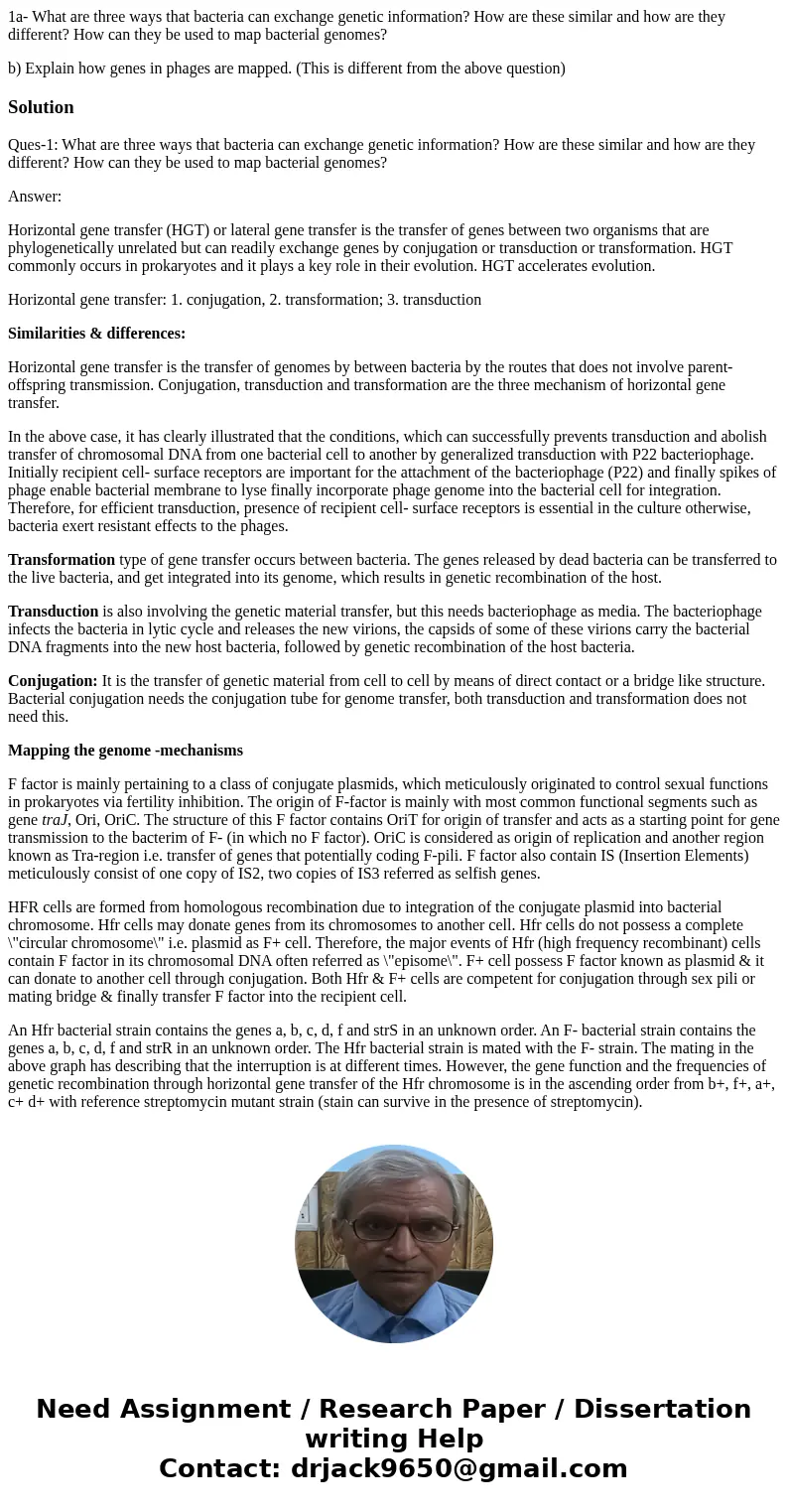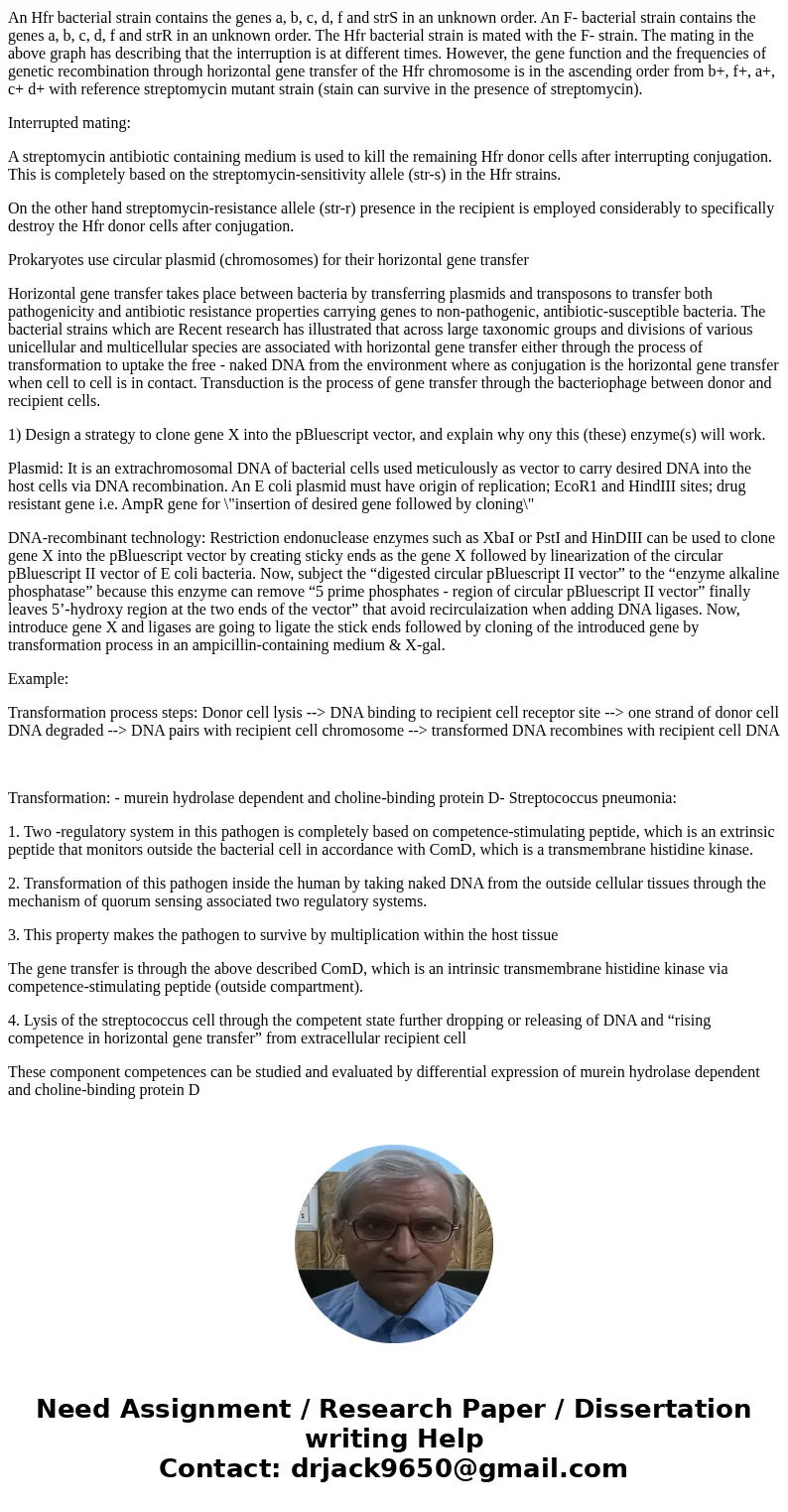1a What are three ways that bacteria can exchange genetic in
1a- What are three ways that bacteria can exchange genetic information? How are these similar and how are they different? How can they be used to map bacterial genomes?
b) Explain how genes in phages are mapped. (This is different from the above question)
Solution
Ques-1: What are three ways that bacteria can exchange genetic information? How are these similar and how are they different? How can they be used to map bacterial genomes?
Answer:
Horizontal gene transfer (HGT) or lateral gene transfer is the transfer of genes between two organisms that are phylogenetically unrelated but can readily exchange genes by conjugation or transduction or transformation. HGT commonly occurs in prokaryotes and it plays a key role in their evolution. HGT accelerates evolution.
Horizontal gene transfer: 1. conjugation, 2. transformation; 3. transduction
Similarities & differences:
Horizontal gene transfer is the transfer of genomes by between bacteria by the routes that does not involve parent-offspring transmission. Conjugation, transduction and transformation are the three mechanism of horizontal gene transfer.
In the above case, it has clearly illustrated that the conditions, which can successfully prevents transduction and abolish transfer of chromosomal DNA from one bacterial cell to another by generalized transduction with P22 bacteriophage. Initially recipient cell- surface receptors are important for the attachment of the bacteriophage (P22) and finally spikes of phage enable bacterial membrane to lyse finally incorporate phage genome into the bacterial cell for integration. Therefore, for efficient transduction, presence of recipient cell- surface receptors is essential in the culture otherwise, bacteria exert resistant effects to the phages.
Transformation type of gene transfer occurs between bacteria. The genes released by dead bacteria can be transferred to the live bacteria, and get integrated into its genome, which results in genetic recombination of the host.
Transduction is also involving the genetic material transfer, but this needs bacteriophage as media. The bacteriophage infects the bacteria in lytic cycle and releases the new virions, the capsids of some of these virions carry the bacterial DNA fragments into the new host bacteria, followed by genetic recombination of the host bacteria.
Conjugation: It is the transfer of genetic material from cell to cell by means of direct contact or a bridge like structure. Bacterial conjugation needs the conjugation tube for genome transfer, both transduction and transformation does not need this.
Mapping the genome -mechanisms
F factor is mainly pertaining to a class of conjugate plasmids, which meticulously originated to control sexual functions in prokaryotes via fertility inhibition. The origin of F-factor is mainly with most common functional segments such as gene traJ, Ori, OriC. The structure of this F factor contains OriT for origin of transfer and acts as a starting point for gene transmission to the bacterim of F- (in which no F factor). OriC is considered as origin of replication and another region known as Tra-region i.e. transfer of genes that potentially coding F-pili. F factor also contain IS (Insertion Elements) meticulously consist of one copy of IS2, two copies of IS3 referred as selfish genes.
HFR cells are formed from homologous recombination due to integration of the conjugate plasmid into bacterial chromosome. Hfr cells may donate genes from its chromosomes to another cell. Hfr cells do not possess a complete \"circular chromosome\" i.e. plasmid as F+ cell. Therefore, the major events of Hfr (high frequency recombinant) cells contain F factor in its chromosomal DNA often referred as \"episome\". F+ cell possess F factor known as plasmid & it can donate to another cell through conjugation. Both Hfr & F+ cells are competent for conjugation through sex pili or mating bridge & finally transfer F factor into the recipient cell.
An Hfr bacterial strain contains the genes a, b, c, d, f and strS in an unknown order. An F- bacterial strain contains the genes a, b, c, d, f and strR in an unknown order. The Hfr bacterial strain is mated with the F- strain. The mating in the above graph has describing that the interruption is at different times. However, the gene function and the frequencies of genetic recombination through horizontal gene transfer of the Hfr chromosome is in the ascending order from b+, f+, a+, c+ d+ with reference streptomycin mutant strain (stain can survive in the presence of streptomycin).
Interrupted mating:
A streptomycin antibiotic containing medium is used to kill the remaining Hfr donor cells after interrupting conjugation. This is completely based on the streptomycin-sensitivity allele (str-s) in the Hfr strains.
On the other hand streptomycin-resistance allele (str-r) presence in the recipient is employed considerably to specifically destroy the Hfr donor cells after conjugation.
Prokaryotes use circular plasmid (chromosomes) for their horizontal gene transfer
Horizontal gene transfer takes place between bacteria by transferring plasmids and transposons to transfer both pathogenicity and antibiotic resistance properties carrying genes to non-pathogenic, antibiotic-susceptible bacteria. The bacterial strains which are Recent research has illustrated that across large taxonomic groups and divisions of various unicellular and multicellular species are associated with horizontal gene transfer either through the process of transformation to uptake the free - naked DNA from the environment where as conjugation is the horizontal gene transfer when cell to cell is in contact. Transduction is the process of gene transfer through the bacteriophage between donor and recipient cells.
1) Design a strategy to clone gene X into the pBluescript vector, and explain why ony this (these) enzyme(s) will work.
Plasmid: It is an extrachromosomal DNA of bacterial cells used meticulously as vector to carry desired DNA into the host cells via DNA recombination. An E coli plasmid must have origin of replication; EcoR1 and HindIII sites; drug resistant gene i.e. AmpR gene for \"insertion of desired gene followed by cloning\"
DNA-recombinant technology: Restriction endonuclease enzymes such as XbaI or PstI and HinDIII can be used to clone gene X into the pBluescript vector by creating sticky ends as the gene X followed by linearization of the circular pBluescript II vector of E coli bacteria. Now, subject the “digested circular pBluescript II vector” to the “enzyme alkaline phosphatase” because this enzyme can remove “5 prime phosphates - region of circular pBluescript II vector” finally leaves 5’-hydroxy region at the two ends of the vector” that avoid recirculaization when adding DNA ligases. Now, introduce gene X and ligases are going to ligate the stick ends followed by cloning of the introduced gene by transformation process in an ampicillin-containing medium & X-gal.
Example:
Transformation process steps: Donor cell lysis --> DNA binding to recipient cell receptor site --> one strand of donor cell DNA degraded --> DNA pairs with recipient cell chromosome --> transformed DNA recombines with recipient cell DNA
Transformation: - murein hydrolase dependent and choline-binding protein D- Streptococcus pneumonia:
1. Two -regulatory system in this pathogen is completely based on competence-stimulating peptide, which is an extrinsic peptide that monitors outside the bacterial cell in accordance with ComD, which is a transmembrane histidine kinase.
2. Transformation of this pathogen inside the human by taking naked DNA from the outside cellular tissues through the mechanism of quorum sensing associated two regulatory systems.
3. This property makes the pathogen to survive by multiplication within the host tissue
The gene transfer is through the above described ComD, which is an intrinsic transmembrane histidine kinase via competence-stimulating peptide (outside compartment).
4. Lysis of the streptococcus cell through the competent state further dropping or releasing of DNA and “rising competence in horizontal gene transfer” from extracellular recipient cell
These component competences can be studied and evaluated by differential expression of murein hydrolase dependent and choline-binding protein D


 Homework Sourse
Homework Sourse